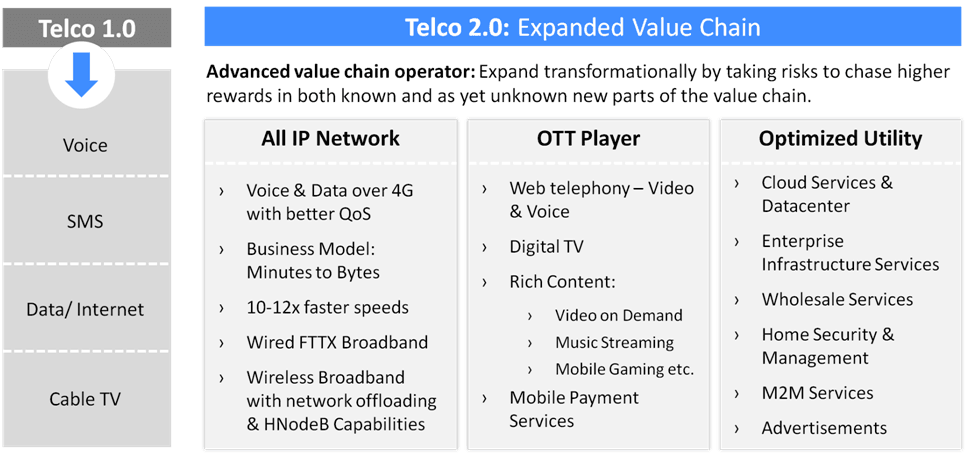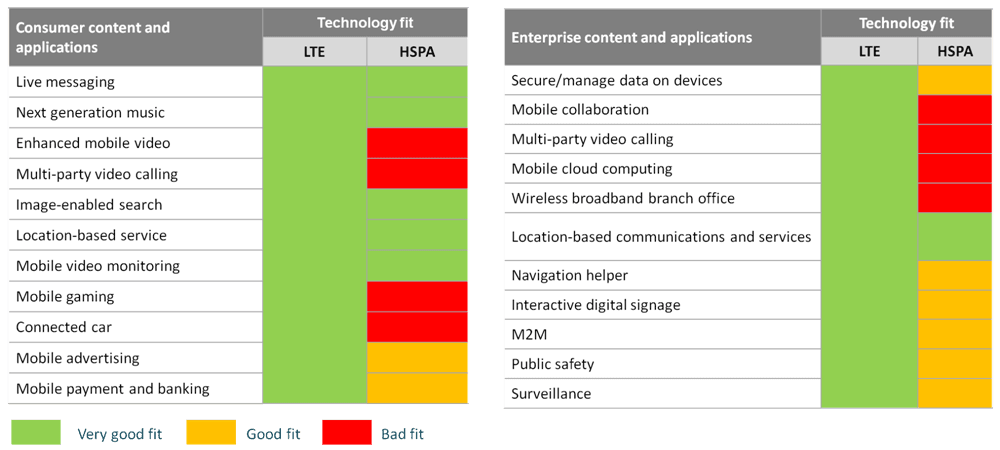Factors Complicating Assurance in 4G Environments
GSMA has a vision for 2020 for Telecommunications Industry around connected living which focuses on main pillars which are expected to drive the industry forward, namely – Network 2020, Personal Data, Internet of Things and Digital Commerce.
As per my view, the single most important take away from that vision is the rise of Telco 2.0.
Telco 2.0 are those telecom operators which are expected to expand transformationally by taking risks to chase higher rewards in both known and as yet unknown new parts of the value chain. These are expected to be the most advanced & disruptive Telecom Operators.
The most important enabler of these, so called, Telco 2.0 operators would be the ‘platform’ which would allow them to explore & experiment with those unknowns and expand services while ensuring higher customer experience which will help them achieve that visionary status.
One of such platforms is 4G, which riding on the inability of 3G-3.5G networks in delivering the required quality of service, has shown tremendous adoption rate within operators over the years.
What has made 4G enabled networks so popular is its proven capability as an ideal platform for cross domain services convergence & all access technologies.
A comparison between 4G LTE & HSPA (~3G) based network and service delivery capabilities can be seen below:
The bitmap above also provides a crude reasoning around lower adoption rate of certain services which were also rolled out over 3G enabled networks, but did not meet the consumer expectations around quality, reliability and price.
4G based networks provide the ability to the operators to become the ‘Real’ converged service providers, which until 3G was more theory than practicality. Operators are now becoming OTT service providers including communication, social media, social network, content, advertisement etc., connected living enablers, enterprise enablers etc. which was, until now, being offered mostly by 3rd parties.
With operator owning the converged service offerings (or at-least controlling some part of the service delivery like quality etc.), the increase in traffic over its pipes has shown potential of increase in direct revenues, that too proportionately.
Factors influencing complexity in 4G environment
Yes. 4G is great! But, not without the share of complexities it injects in the area of assurance (RA & Fraud) operations.
The following variables are identified to be the main influencers with respect to complexity and uncertainty in 4G environments:
New Network Elements
4G introduces new set of network elements and O/BSS systems generally being customized in terms of design or implementation as per the operator raising concerns around interfacing, data availability or quality. This also points to increase in complexity & volume of RA & FM activities to be performed due to increased data sources and controls.
Also, a lot of components in 4G implementations are still not COTS and provide different logging & access levels which raising concerns around capability around identification of internal frauds and external access attempts/brute force attacks.
Parallel Networks
Traditional networks including certain components adopted from 2G, 3G environment and running in parallel to enable backward compatibility and interconnection leads to further increase in risk, complexity and number of controls to be managed.
Non Standard Implementations
Some areas of 4G network, O/BSS systems and interface partnerships (operator, content providers etc.) are being implemented in customized non-standard fashion to enable interconnections (including roaming approach) and support complex products and service offerings (like VoLTE or VoLTE roaming etc.). The situation is more of an experiment and working towards developing a standard rather than following one.
Lack of reference 4G RA & FM practices combined with custom implementations, RA & FM activities are expected to be driven by non standard data sets and frequencies until stability/maturity.
Initially in 4G space, RA & FM practices may be exposed to the scenario of ‘Incident induced learning’ or ‘reactive RA & FM’.
Higher Convergence
Higher convergence of ‘core’ telecom operator provided services introduces more ‘direct’ risks to the operator and an increased need to manage RA & fraud risks introduced by the new services, which in an earlier setting, was a headache of the third party service provider.
New Pricing Models
Conversion to charging policies from minutes to bytes (sessions) and bytes to service subscription & access mixed with complex bundling packs & rate plans is expected to change the traditional mindset of conducting RA & FM, especially around charging, discounting, billing & invoicing.
Disruptive roaming charging policies are also expected to be introduced which will change the perspective further.
For session based charging policy, verification of policy implementation is also expected to impose its own set of challenges.
Complex service offerings
Telecom operators are going beyond their traditional service offerings (Apart from voice and data – TV / content / cloud etc.) and venturing into the modern areas revenue generation such as content, advertisements, connected living etc.
Rich content (VoD, music, messgaging, magazines etc.) management & delivery to become the fulcrum 4G revenues. Also, with various channels of content delivery at hand, advertisement revenues will also play an important role for mature 4G operators
But, service based subscriptions, validity & dynamic delivery along with innovative & complex content and partner agreements are expected to complicate the RA & FM activities like never before.
Increase in transaction volumes
4G subscriptions is expected to increase 3.5 folds to 1.3 billion and data traffic by 6 folds to 17 Exabytes by Dec 2018. Operators will be dealing with many fold increase in data per unit of earned Revenue.
Considering revenues are tied to data sessions, transaction volume mgmt. for the purpose of RA & FM is expected to introduce a big challenges and would require advance data treatment, management & analysis techniques (e.g. Big data).
Responsiveness & Scalability is expected to be one of the main talking points with respect to volume management
Rapid Product & Services Launch
New product, package and service launch across the breath of 4G enabled service platforms are expected to see a considerable rise in throughput due to shortened development, delivery & release cycle.
The agility of RA & FM departments in terms of proactive assessment and risk readiness is expected to keep pace with the higher number of products, services and packages being launched at the breakneck speed across the breath of business offerings
Margin Management & Revenue Enhancement
With increased competition, Revenues are expected to be driven by high volumes and low margins and not high margins. Product performance measurement in terms of adoption and revenue generation against target will have to be carried out at much higher frequency.
With RA having and access to all cost items, charging, payins/payouts, usage records, quality parameters and first visibility to trends and anomalies, margin management and revenue enhancement activities are expected to take center stage
Skill set and technology within the team will have to be enhanced or absorbed to enable and handle increased cross functional interfacing , analytics and product management
Lack of Skill Set
Lack of mature reference 4G implementations is also expected to lead to lack of required skill set which is needed to manage and continuously improve the RA & FM operations. There will be focus on more laborious, reactive & risk prone approach of skill ‘creation’ rather than ‘absorption’
Updated Network Access Authentication Methods
Operators need risk readiness against newer authentication methods which are different for different services – ISIM, USIM, Single Sign On etc. Considering device authentication & security is in the hands of the manufacturer or the OS provider, any security flaw is a direct risk to the subscriber base of the operator
Also, 3rd party firmwares & apps are readily available for the assistance of hackers. This situation increases the device or OS takeover further.
Increased UE & CPE Types
Exponential increase in multi vendor UE & CPE types has increased user exposure to IP frauds like takeovers (Accounts or UE) enhanced by ‘easy’ service access methods such as ‘single sign on’ for single or multiple services.
While user equipments are highly exposed to malicious Apps, URLs, Malwares etc., readily available custom firmware for Customer Premise Equipment are found to expose them to the same level of risks.
To top it off, high profile sensitive customer information hacking cases by external sources are on the rise both against individual subscriber and enterprise networks, calling for much more robust, secure and continuously improving infrastructure and detection capabilities.
Power user exploits
Power users or technology aware users are expected to exploit any loopholes in the implementation of service access, newer pricing models etc. through the use of various complex techniques such as URL masking etc. to bypass charging and gain free access to services
Spoofing or device configuration updates like MAC Address may also gain popularity to help divert charging to someone else in absence of adequate authentication and multi level device binding mechanisms
Movement to 4G or a higher capability environment is inevitable.
I believe, if traditional approach to manage RA & FM operations is continued as it is even for 4G environments, these functions are expected to attract steep investments to manage complexity factors mentioned above (including increase in network elements & O/BSS systems, data streams, data loads, controls, resourcing, technology requirements etc.).
There is an immediate need of shifting from current mindset and adopting “Smart” & “Agile” RA & FM practices across the operational spectrum (of people, process, measurement, organization & technology) to contain costs and risks much more efficiently.
Taking a cue from Game of Thrones – “Winter is coming! and this one will be long. God help us all if we’re not ready!”
Abhijeet is currently working as Principal Consultant with Subex.
He specializes in Telecom Fraud Management and his 360 degree experience in this field includes extensive exposure in Fraud Operations Management, Consulting & Advisory, Risk & Health Assessments, Business Development – Product & Managed Services and Analytics.
Out of professional life, he is a blogger, tech enthusiast and a traveler.
Request a demo





